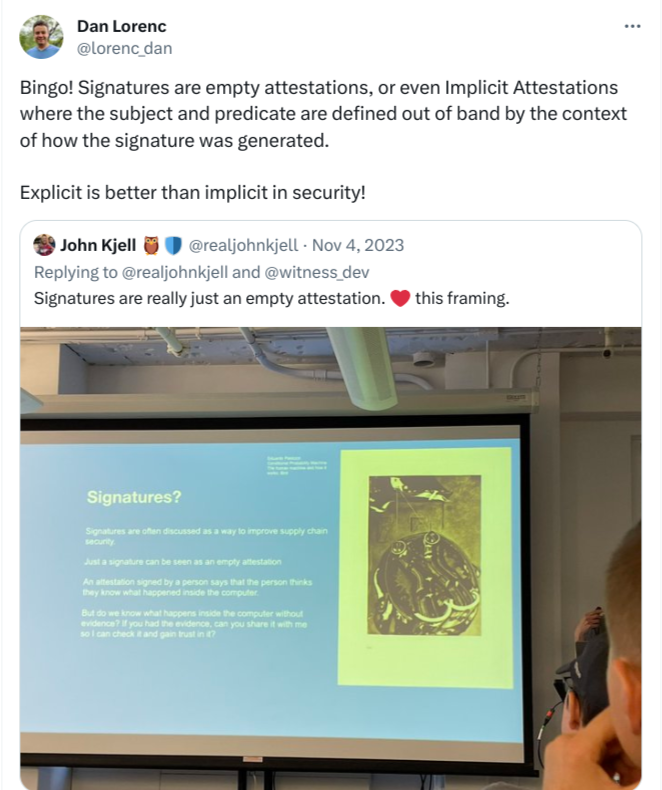Code Signing is not Enough
Code signing is often used as a method for ensuring that software artifacts
like binaries, drivers, and software packages haven’t been modified by a third
party before they are used. Many folks may be familiar with packages that were
gpg signed and distributed with an Armored ASCII (.asc) file. Code signing
is a great step towards securing the software supply chain above simply
providing software as-is, but has a number of downsides that can be addressed
with other methods like software provenance.
Signing Code
Code signing is the name given to cryptographically signing release artifacts
with a cryptographic key. In the past, PGP and the GNU implementation gpg
have been popular methods used for code signing. Another method that has gained
popularity recently is to use the sigstore
project’s cosign tool to sign artifacts with short-lived keys.
By signing an artifact your users can cryptographically guarantee that the artifact they are using is byte-for-byte identical to the artifact that was signed using the developer’s key. The key itself can contain a bit of metadata about the company name, timestamps, etc. and this information can be used to ensure it is coming from a trusted party before the artifact is executed.
However, there are a number of ways that code signing doesn’t go far enough to protect users from malicious artifacts. Software provenance achieves the same goals using a similar method but goes farther by tackling the problem of verifying software artifacts more directly.
Let’s take a look at what provenance is, then we can compare it with code signing to see how it goes further to protect users.
Software Provenance
Provenance is a set of metadata that is produced along with a software artifact when it is created that describes how the software artifact was created. Typically this is done as part of a CI/CD build pipeline and includes information such as the source code repository and revision used to build the artifact, and the CI/CD build system itself.
Provenance metadata is usually created and stored in a machine readable format like JSON. To ensure the integrity of the metadata, provenance is then signed using a cryptographic key much like code signing and distributed with the resulting signature. It can contain more information specific to each build such as the builder (e.g. GitHub Actions), source code repo & commit, and build inputs. By combining the metadata and the signature together we get what’s called a provenance “attestation” because it attests to how the software was built.
One important aspect of provenance is that it can be created in a more trustworthy way, typically by the CI/CD system itself. This means that the metadata cannot be tampered with by normal users of the CI/CD build system like code contributors.
Attestations over Inferences
One of the key tenets of the Supply-chain Levels for Software Artifacts (SLSA) framework is “Prefer attestations over inferences”. The slsa.dev website says:
Require explicit attestations about an artifact’s provenance; do not infer security properties from a platform’s configurations.
What this means is that we should avoid making assumptions about a software artifact based on how we think it was created. Code signing makes exactly these kinds of implied assumptions.
For example, let’s assume that we have a software artifact that was signed by a key that is owned by the software’s author.
How do we know where the software was built? We can assume that it was built by the normal release pipeline on GitHub but can we really know for sure?
How do we know what source code was used? We can assume that it was built using the source code in the GitHub repo but the code signature says nothing about that.
Even if we are satisfied that this artifact was built using a secure process and is not compromised, can we be sure of that for other artifacts released by other developers?
We can think of code signing as creating an attestation but that attestation is empty or at least provides very little information explicitly. All information about how the software was built is implied by the signing itself.
Example Supply Chain Attacks
GitHub Actions security vulnerabilities are an often written about topic. One
typical attack is to exploit vulnerabilities in the PR checks. One such example
is with the workflow_run trigger which is triggered when another workflow
completes. If the triggered workflow does not properly validate its inputs from
a PR’s workflow run then it could allow privilege
escalation
via its GITHUB_TOKEN.
Attackers gaining access to a repository could use these elevated permissions to overwrite released binaries or make changes to the codebase. In these situations attackers often try to cover their tracks by deleting the logs of workflow runs or other measures.
However, if generating trustworthy provenance that is generated by GitHub or a separate trusted mechanism, attackers would be more limited in the attacks they can achieve. Attackers would not be able to simply overwrite release binaries because the associated provenance would then fail verification. If attackers modify the source code, the corresponding artifact that was built would be tied back to a compromised commit leaving evidence of the attack and making it easier for downstream users to respond by rejecting those binaries.
The Deliberately Vulnerable GitHub Actions repo is also a fun repository to explore and learn more about common attacks on GitHub Actions workflows.
How to SLSA 💃
In order to make it easier to generate provenance on GitHub Actions we have
built the
slsa-github-generator
project which provides a number of GitHub Actions reusable workflows that can
generate SLSA provenance safely.
This can be as simple as adding a call to the SLSA generator reusable workflow at the end of your release workflow. For example generating provenance for binary built by GoReleaser might look like the following:
jobs:
goreleaser:
outputs:
hashes: ${{ steps.hash.outputs.hashes }}
steps:
- name: Checkout repository
uses: actions/checkout@2541b1294d2704b0964813337f33b291d3f8596b # tag=v3
- name: Run GoReleaser
id: run-goreleaser
uses: goreleaser/goreleaser-action@b953231f81b8dfd023c58e0854a721e35037f28b # tag=v3
- name: Generate subject
id: hash
env:
ARTIFACTS: "${{ steps.run-goreleaser.outputs.artifacts }}"
run: |
set -euo pipefail
hashes=$(echo $ARTIFACTS | jq --raw-output '.[] | {name, "digest": (.extra.Digest // .extra.Checksum)} | select(.digest) | {digest} + {name} | join(" ") | sub("^sha256:";"")' | base64 -w0)
if test "$hashes" = ""; then # goreleaser < v1.13.0
checksum_file=$(echo "$ARTIFACTS" | jq -r '.[] | select (.type=="Checksum") | .path')
hashes=$(cat $checksum_file | base64 -w0)
fi
echo "hashes=$hashes" >> $GITHUB_OUTPUT
provenance:
needs: [goreleaser]
permissions:
actions: read # To read the workflow path.
id-token: write # To sign the provenance.
contents: write # To add assets to a release.
uses: slsa-framework/slsa-github-generator/.github/workflows/generator_generic_slsa3.yml@v1.9.0
with:
base64-subjects: "${{ needs.goreleaser.outputs.hashes }}"
upload-assets: true # upload to a new release
This will generate a signed provenance file that is uploaded to your GitHub release along with the compiled binary. Users can then verify its authenticity with the slsa-verifier tool.
$ slsa-verifier verify-artifact my-go-app \
--provenance-path my-go-app.intoto.jsonl \
--builder-id "https://github.com/slsa-framework/slsa-github-generator/.github/workflows/generator_generic_slsa3.yml" \
--source-uri github.com/ianlewis/my-go-app \
--source-tag v1.0.0
This way we can be sure that my-go-app was built by GitHub Actions from the
appropriate repository’s source code.
Explicit is Better than Implicit
Many folks have read The Zen of Python. It outlines the principles of the Python language and community. But many of its precepts are broadly applicable. The principle of “Explicit is Better than Implicit” is one such example that provenance and the SLSA framework take to heart.
Dan Lorenc at Chainguard said it best:
Learn more about the SLSA framework and supply chain security for open source at slsa.dev. Also check out the slsa-github-generator and slsa-verifier projects.
Now let’s all go make some provenance!

